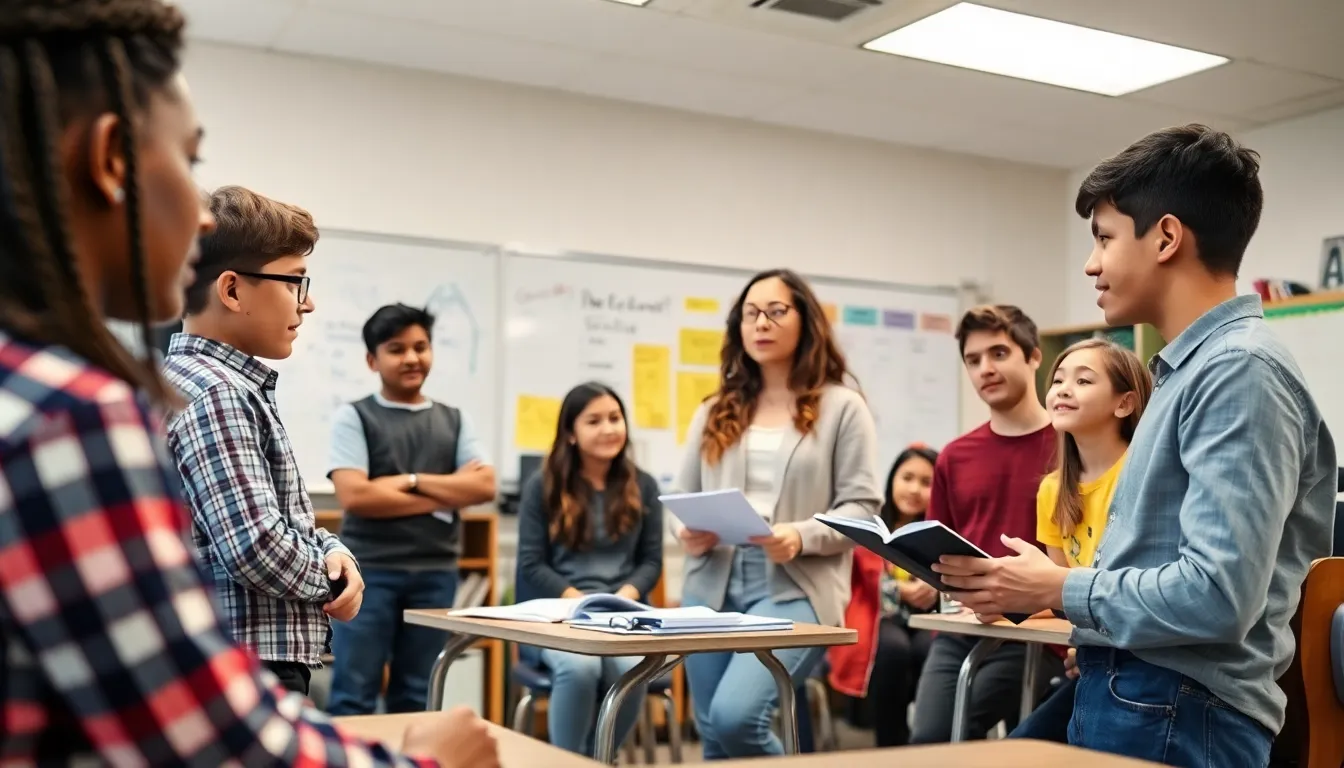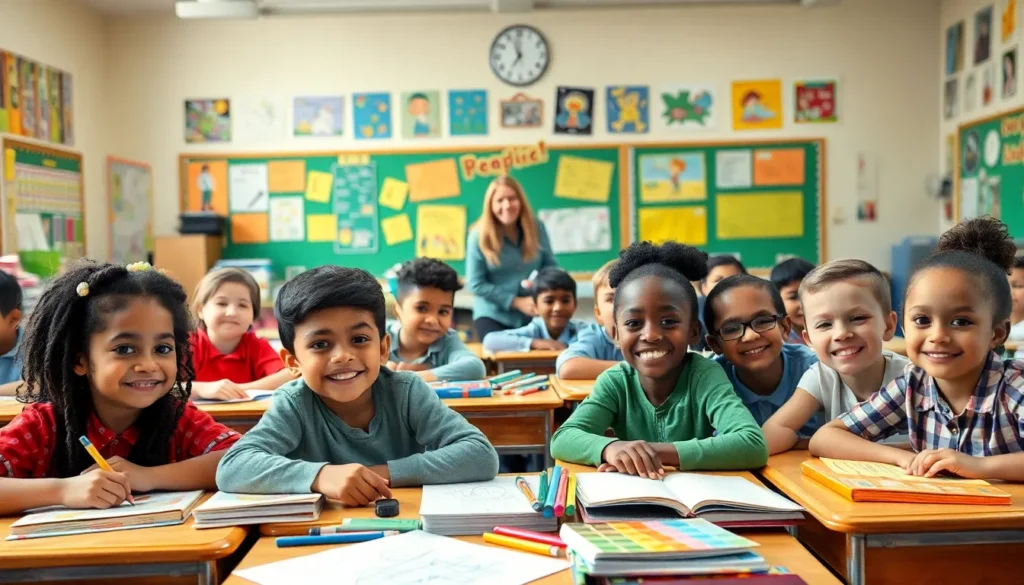Table of Contents
TogglePublic education plays a crucial role in shaping the future of students and communities across the United States. As parents and educators strive to provide the best opportunities for learning, understanding which states excel in public education becomes essential. The quest for quality education often leads families to explore various factors, including funding, teacher qualifications, and student outcomes.
This article dives into the best public education systems by state, highlighting those that stand out for their commitment to academic excellence and innovation. By examining key metrics and trends, readers will discover which states are leading the way in providing an enriching educational experience for their students. Whether you’re a parent considering relocation or simply curious about the educational landscape, this guide offers valuable insights into the best public education options available.
Overview of Public Education in the U.S.
Public education in the United States serves as a cornerstone for societal development, influencing individual futures and community growth. Each state’s system reflects diverse approaches to education, highlighting variations in implementation and quality.
Key Factors in Public Education
- Funding: Public education funding varies significantly by state, impacting resources available for schools. States with higher per-student spending often provide better facilities and educational materials. For example, New York spends approximately $24,000 per student, while Idaho spends about $8,000.
- Teacher Qualifications: States that prioritize teacher qualifications tend to see improved student performance. States such as Massachusetts require rigorous certification processes and ongoing professional development, which correlate with high test scores.
- Student Outcomes: Evaluating student outcomes involves measuring performance on standardized tests, graduation rates, and college readiness. For instance, states like New Jersey and Virginia consistently rank high in student achievement metrics.
- Curriculum Standards: States establish varying curriculum standards that shape educational practices. Common Core State Standards, adopted by many states, aim to enhance educational quality and consistency across the nation.
- Innovative Programs: States that implement innovative educational programs attract attention for their effectiveness. For instance, Florida’s school choice initiative allows families to select schools that align with their children’s needs, fostering competition and improvement in public schools.
Trends in Public Education
- Equity in Education: Ensuring equitable access to quality education remains a challenge. States are implementing policies aimed at closing achievement gaps based on socioeconomic status and race.
- Technology Integration: Increasing technology integration in classrooms enhances learning experiences. States like California lead in incorporating digital resources and tools to support interactive learning.
- Early Education Initiatives: States emphasizing early childhood education programs report higher long-term success rates in academics. Programs in states like Georgia deliver valuable pre-K experiences that contribute to school readiness.
- Mental Health Support: Many states are incorporating mental health resources into public education, recognizing the importance of mental well-being for student success. Schools in Colorado, for instance, provide support programs that address students’ emotional needs.
Public education in the U.S. encompasses a wide range of factors and trends that contribute to its effectiveness and challenges. By understanding these elements, stakeholders can better assess the landscape and make informed decisions regarding educational opportunities.
Criteria for Evaluating Public Education

Evaluating public education requires an examination of various critical metrics. Key factors include academic performance, resource allocation, and teacher qualifications.
Academic Performance
Academic performance reflects students’ proficiency in core subjects. Key metrics include standardized test scores, graduation rates, and college readiness indicators. States like Massachusetts maintain high average scores in math and reading assessments, showcasing effective instructional strategies. States that prioritize comprehensive curricula and robust assessment systems often demonstrate improved student outcomes.
Resource Allocation
Resource allocation encompasses funding levels, class sizes, and access to educational materials. States with higher per-student spending typically provide more resources for facilities and technology. For example, New York invests significantly in public education, resulting in more comprehensive support services. Effective resource allocation often correlates with enhanced student performance and broader educational opportunities.
Teacher Qualifications
Teacher qualifications influence classroom effectiveness and student success. States that emphasize certification requirements, ongoing professional development, and competitive salaries attract and retain skilled educators. States like California and Connecticut feature stringent certification processes, contributing to improved educational outcomes. Strong teacher qualifications ensure that students receive quality instruction, driving academic achievement.
Top States for Public Education
Several states lead the nation in public education quality, marked by strong funding, high teacher qualifications, and impressive student outcomes. These states showcase systems that prioritize academic excellence and innovative practices.
State 1: Overview and Highlights
Massachusetts ranks at the top for public education, boasting high student performance metrics. The state features rigorous teacher certification processes, enhancing the overall quality of instruction. Massachusetts achieves graduation rates of 90% and surpasses the national average on standardized tests, like the SAT and MCAS, demonstrating effective learning strategies and resource allocation.
State 2: Overview and Highlights
New Jersey follows closely, renowned for its comprehensive education funding and robust support for students. The state allocates over $15,000 per student annually, providing access to advanced coursework and extracurricular programs. New Jersey consistently ranks among the highest in college readiness, with more than 80% of high school graduates pursuing higher education after graduation.
State 3: Overview and Highlights
Virginia offers a strong public education framework characterized by well-trained teachers and high academic standards. The state adopts a goal-oriented approach, promoting educational attainment through initiatives like the Virginia Preschool Initiative. Virginia schools report a graduation rate exceeding 90% and excel in STEM education, preparing students for careers in technology and engineering fields.
Challenges Facing Public Education
Public education systems in the United States encounter various challenges that impact their effectiveness and reach.
Funding Issues
Funding disparities represent a significant challenge in public education. States differ markedly in per-student spending, affecting resources for teachers, facilities, and student support services. For instance, New York allocates approximately $25,000 per student, while Idaho spends around $8,000 per student. Lower funding often results in larger class sizes, fewer educational materials, and limited extracurricular activities. This inequity can lead to divergent educational outcomes, with underfunded schools struggling to provide quality instruction and support.
Equity and Access
Equity and access issues further complicate public education. Students from low-income families often face barriers in accessing high-quality education. Factors such as geographic location, socioeconomic status, and ethnic background influence the quality of educational opportunities available. For example, rural schools may lack advanced placement courses or specialized programs, limiting pathways to higher education. Additionally, schools in urban areas might be overcrowded and under-resourced, exacerbating disparities. Addressing these issues is crucial for ensuring that all students receive a fair opportunity to succeed academically.
Public education plays a vital role in shaping the future of students and communities. Recognizing which states excel in this area helps parents and educators make informed decisions. By focusing on critical factors like funding, teacher qualifications, and student outcomes, stakeholders can identify systems that prioritize academic excellence and innovation.
As the landscape of public education continues to evolve, understanding the strengths and challenges faced by different states is essential. This knowledge empowers families to seek out the best opportunities for their children and advocates for improvements in education across the nation. Ultimately, a commitment to enhancing public education can lead to lasting benefits for students and society as a whole.




